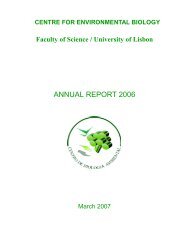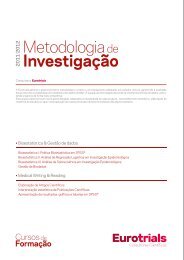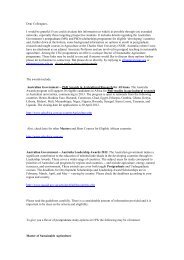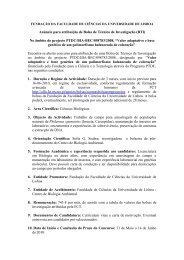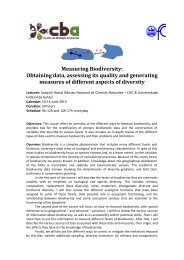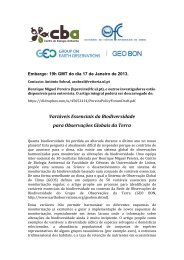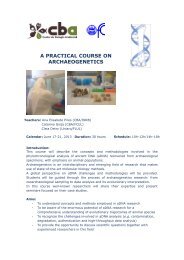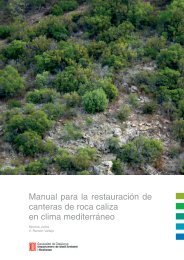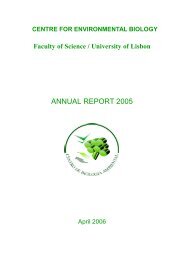European Red List of Vascular Plants - European Commission
European Red List of Vascular Plants - European Commission
European Red List of Vascular Plants - European Commission
Create successful ePaper yourself
Turn your PDF publications into a flip-book with our unique Google optimized e-Paper software.
meres, have level and flow regimes tied to the behaviour<br />
<strong>of</strong> the water table. Abstraction <strong>of</strong> water from the ground,<br />
both for potable supply and agricultural use, is known to<br />
affect both the levels and the periodicity <strong>of</strong> fluctuation <strong>of</strong><br />
water tables which in turn affect the timing and quantity<br />
<strong>of</strong> supply to natural springs and seepages upon which<br />
these wetland and river plants depend. The abstraction<br />
<strong>of</strong> water from rivers and lakes leads as well to ecological<br />
change with various consequences including the decrease<br />
<strong>of</strong> surface area <strong>of</strong> flooded wetlands and the duration <strong>of</strong><br />
flooding.<br />
Rivers and other wetlands have been modified since<br />
humans first started to grow crops and keep livestock,<br />
from minor diversions to form stock ponds up to hard<br />
defences, channelization and damming <strong>of</strong> major rivers.<br />
In many countries, even the smallest high altitude flushes<br />
and headwaters have been modified. In the uplands <strong>of</strong><br />
the UK, for example, sheep farmers routinely dam and<br />
divert the small streams which will eventually become<br />
our main rivers; in many areas unregulated exploitation<br />
<strong>of</strong> river gravels destroys the structure and vegetation <strong>of</strong><br />
river floodplains. It appears likely that in much <strong>of</strong> Europe<br />
the vegetation <strong>of</strong> rivers has been in severe decline for<br />
hundreds <strong>of</strong> years and it is difficult to establish which<br />
species natural river systems would have supported.<br />
Most wetland types are naturally highly dynamic,<br />
resulting from natural processes at the ecosystem level,<br />
e.g. seasonal and non-seasonal fluctuations <strong>of</strong> water<br />
levels, succession to other habitats, the lateral movement<br />
<strong>of</strong> rivers and the actions <strong>of</strong> large herbivores. Many aquatic<br />
and wetland plant populations appear to function as<br />
dynamic metapopulations; these populations are linked<br />
by exchange <strong>of</strong> genetic material (e.g. pollen, propagules<br />
or even plant fragments) thus increasing their resilience<br />
to natural changes in the availability <strong>of</strong> suitable habitats.<br />
Modification <strong>of</strong> wetland systems and complexes disrupts<br />
connections between populations within metapopulations<br />
by increasing the distance between patches further<br />
enhancing the probability <strong>of</strong> extinction. Fragmentation<br />
<strong>of</strong> wetland habitats also leads to the decrease in the total<br />
surface area and thus in the total size <strong>of</strong> populations, as<br />
well as the size <strong>of</strong> the remaining habitat patches which<br />
increases their vulnerability.<br />
Aquatic plants are <strong>of</strong>ten sensitive to changes in their<br />
freshwater environments such as increases in nutrients,<br />
changes in salinity, pH, temperature, etc. and they may be<br />
important as indicators <strong>of</strong> ecosystem health. It is therefore<br />
not surprising that pollution is a big threat and the main<br />
cause is the use <strong>of</strong> fertilisers and herbicides or pesticides<br />
in agricultural landscapes. Nutrient levels in wetlands are<br />
increasing, through run-<strong>of</strong>f from agriculture, sediment<br />
leaching in from various practices which break up the<br />
soil surface, from fish-farming and from atmospheric<br />
deposition. Whilst the evidence for direct impacts <strong>of</strong><br />
increased nutrient loads on aquatic and wetland plants<br />
is scant, they are extremely vulnerable to the knockon<br />
effects <strong>of</strong> increased nutrient loads, developing<br />
from an increase in productivity and the replacement<br />
<strong>of</strong> oligotrophic species (which are <strong>of</strong>ten rare, such as<br />
Eryngium viviparum and Thorella verticillato-inundata)<br />
by meso- and eutrophic-species including aggressive<br />
colonial perennial grasses and exotic invasive species;<br />
if enrichment continues, most higher plants disappear,<br />
displaced by algal mats, phytoplankton and eventually<br />
anoxic crises. Eutrophication <strong>of</strong> large water bodies tends<br />
to slow down or decrease in developed countries; however<br />
eutrophication <strong>of</strong> headwaters is <strong>of</strong>ten increasing as is use<br />
<strong>of</strong> xenobiotic pollutants such as herbicides. Pollution<br />
from domestic or industrial sources and garbage disposal<br />
is affecting the ecosystem in similar ways.<br />
Recreational use <strong>of</strong> water bodies is another threat<br />
factor; plants can suffer from excessive trampling due<br />
to recreational activities or from work activities such as<br />
removal <strong>of</strong> vegetation while “cleaning up” water bodies.<br />
Similarly, water sports have, for example, been described<br />
as a threat to Isoetes boryana which grows in shallow water<br />
on the margins <strong>of</strong> large lakes<br />
The invasion <strong>of</strong> exotic species such as Crassula helmsii,<br />
Ludwigia species and Sagittaria subulata leads to increased<br />
competition for space with native aquatic plants and<br />
affects most threatened aquatic plant species. Climate<br />
change and particularly an increase in droughts pose a<br />
problem for aquatic plants especially in the Mediterranean<br />
countries. The direct effect is that less suitable habitat will<br />
be available but this be aggravated by higher demand on<br />
the existing water resources in times <strong>of</strong> drought. Several<br />
consecutive dry years may also adversely affect the<br />
reproduction capacity <strong>of</strong> some species.<br />
5.5 Population trends<br />
In addition to the complexities <strong>of</strong> definition <strong>of</strong> aquatic<br />
plants and taxonomic issues, there are fundamental<br />
problems with attempts to quantify population trends<br />
for aquatic plants. Many, if not most aquatic plants<br />
reproduce mainly by vegetative means, either through<br />
fragmentation followed by rooting <strong>of</strong> fragments, such<br />
as water-starworts (Callitriche), or by turions, such as<br />
pondweeds (Potamogeton); they may also reproduce by self-<br />
41



